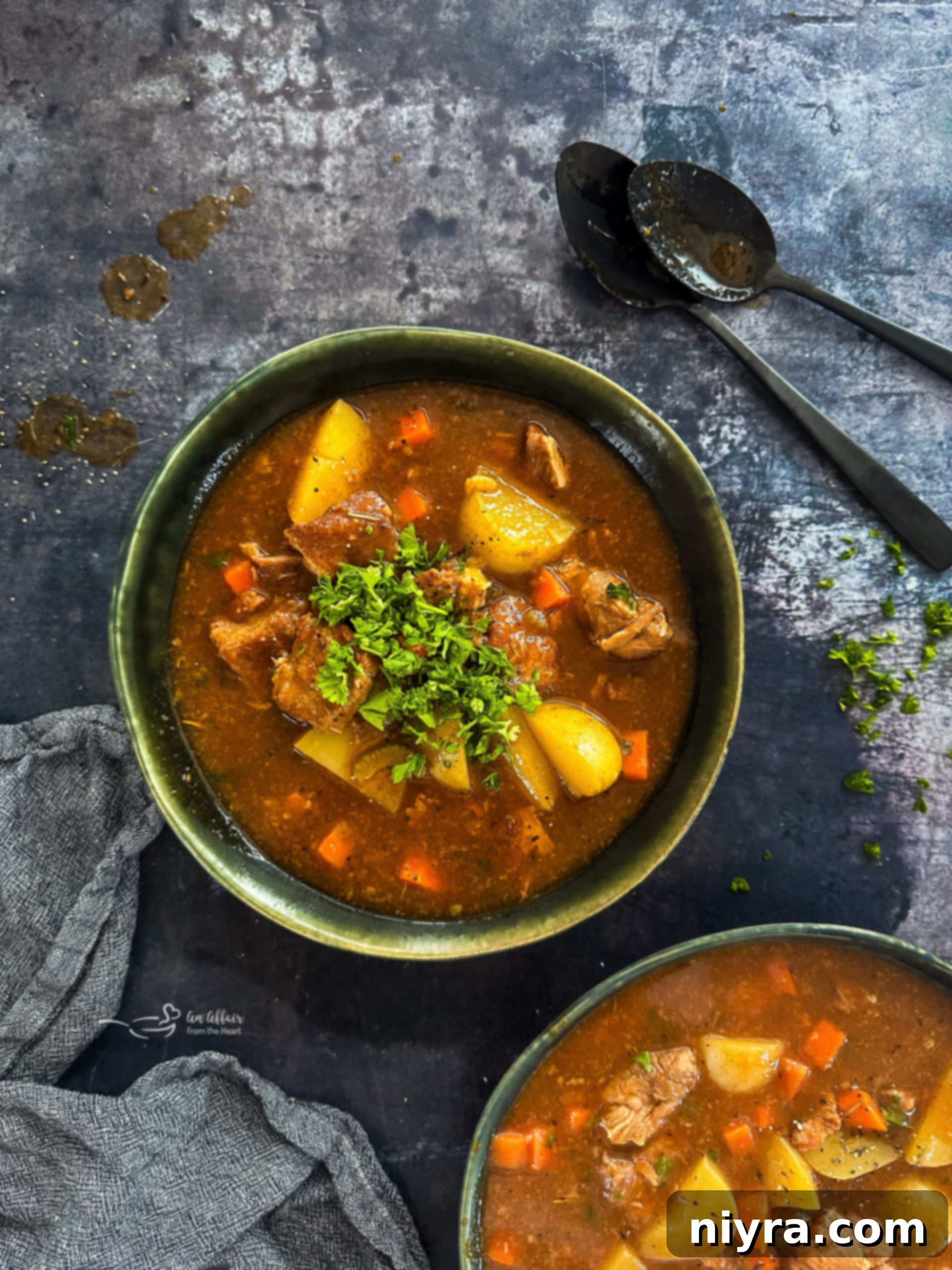There’s an undeniable allure to a truly hearty pork stew, especially as the temperatures begin to drop and crisp autumn air transitions into the chill of winter. The aromatic spices and savory goodness simmering on your stovetop create an instant sense of warmth and comfort, a culinary embrace that promises to satisfy both body and soul. Each spoonful delivers succulent chunks of tender pork, perfectly complemented by soft vegetables and a rich, deeply flavored broth – a classic comfort meal that you’ll undoubtedly want to revisit time and time again. This inviting recipe relies on simple, wholesome ingredients and the magic of slow cooking, transforming humble components into a stew brimming with exceptional depth and flavor, reminiscent of cherished family recipes.
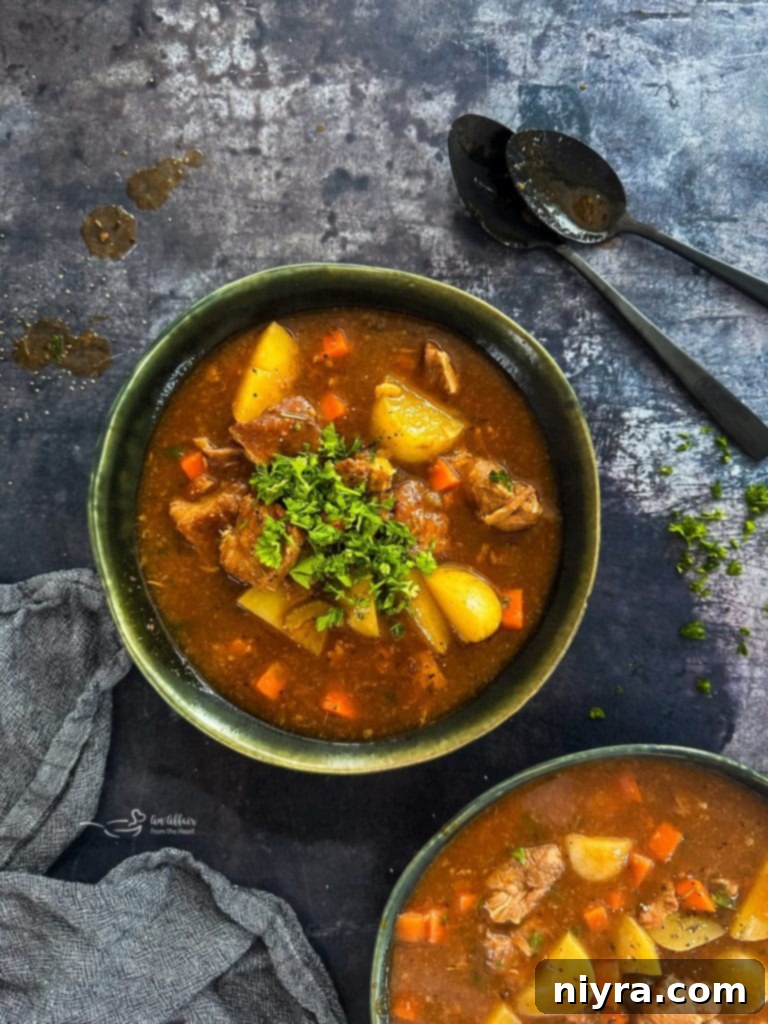
As the “ber months” – September, October, November, and December – usher in shorter days and cooler nights, our cravings naturally shift towards meals that offer warmth and nourishment. While some, myself included, can enjoy a steaming bowl of soup or stew even on a warm patio, there’s something uniquely special about these colder months that makes a comforting dish like this pork stew truly shine. It’s the perfect culinary embrace for the season, transforming simple ingredients into a deeply satisfying experience. This delightful pork stew recipe is designed to be your go-to comfort food throughout the chilly seasons, offering a delicious escape into cozy flavors.
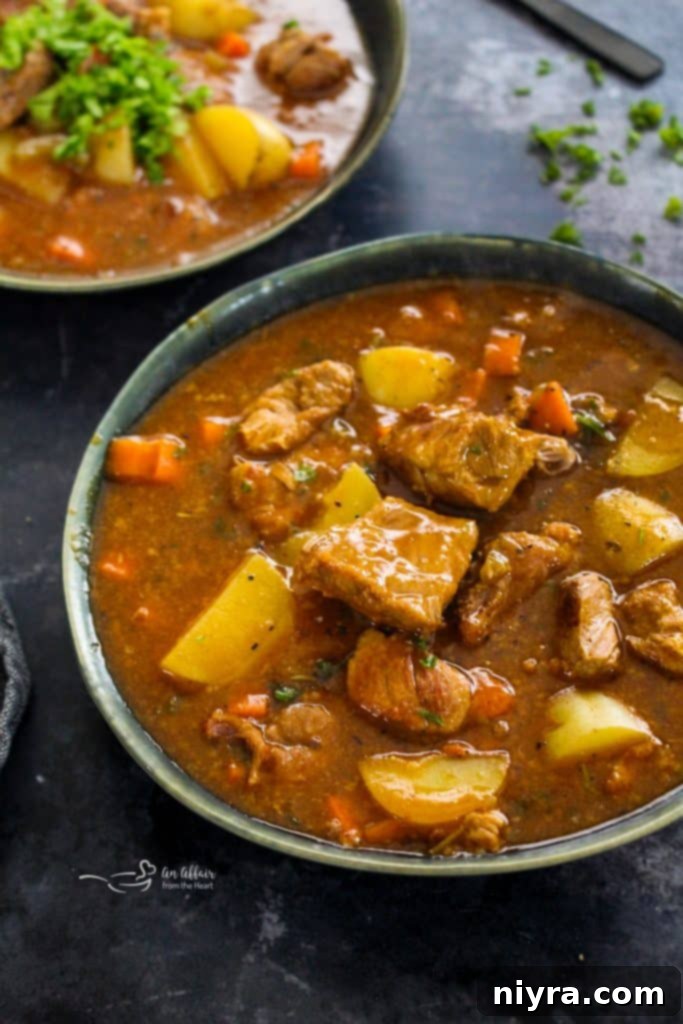
The Ultimate Hearty Pork Stew Recipe
Creating a truly memorable pork stew begins with selecting the right cut of meat. For this stovetop method, pork shoulder, often referred to as pork butt, is the undisputed champion. Its generous marbling of fat and abundant connective tissue are precisely what make it perfect for slow cooking. As the stew gently simmers, this connective tissue gradually breaks down, transforming into gelatin that infuses the broth with incredible richness and leaves you with unbelievably fork-tender pieces of meat that practically melt in your mouth. While leaner cuts like pork loin or pork tenderloin can be used in a pinch, they won’t yield the same depth of flavor or buttery texture as the shoulder. Regardless of your choice, pork stew meat remains a versatile and affordable option that consistently earns rave reviews from the whole family. We are fortunate to have access to such high-quality pork, a testament to the dedication of Iowa pork farmers and producers across the USA who make recipes like this heartwarming stew possible.
Iowa Pork sponsors this post, but my passion for pork recipes and my appreciation for Iowa Pork are entirely my own.
Why This Pork Stew Recipe Stands Out
What sets this particular pork stew recipe apart is its remarkable approachability and the incredible depth of flavor achieved with everyday ingredients. The cooking process is straightforward, starting with browning the meat directly in a large Dutch oven on the stovetop. This initial step is crucial for developing a rich base of flavor. The browned bits that collect at the bottom of the pot, known as ‘fond,’ are then scraped up and incorporated when you stir in the tomato sauce, fresh garlic, and other aromatics. This deglazing technique adds layers of umami and complexity that truly elevate the stew. While a Dutch oven provides excellent heat distribution and retention, making it ideal for this dish, the recipe is also easily adaptable for a slow cooker for those days when you need a more hands-off approach. It’s a versatile recipe designed to fit your cooking style without compromising on taste.
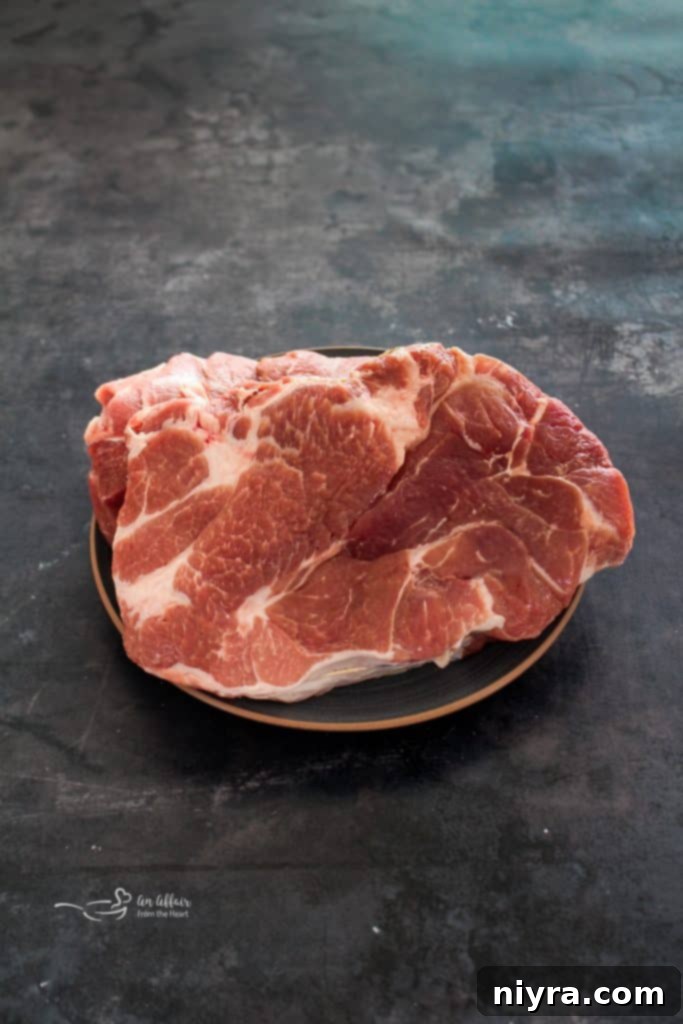
Understanding Pork Shoulder Roast for Stew
Pork shoulder roast is a robust cut sourced from the upper portion of the pig’s front leg, situated just above the foreleg. It’s characterized by its generous marbling of fat and dense network of connective tissues, which makes it supremely well-suited for cooking methods that involve low and slow heat, such as braising, roasting, or stewing. You might encounter this cut labeled as “pork butt” or “Boston butt” at your local grocery store, despite its origin not being from the animal’s rear. This nomenclature is largely historical, stemming from how pork was once packed and shipped in barrels, or “butts.”
Pork shoulder is commonly sold in both bone-in and boneless varieties, with either option working beautifully for this stew. The bone can add a subtle extra layer of flavor to the broth, while boneless cuts offer convenience in preparation. The magic of this cut lies in its transformation during extended cooking: the tough collagen and fat slowly render and break down, yielding incredibly tender, juicy meat. For pulled pork barbecue, you’d aim for an internal temperature of around 190–205°F, allowing it to shred effortlessly. If slicing it as a roast, 145°F is the target. However, for a stew, the visual and textural cues are paramount – you’ll know your pork is perfectly cooked when it’s undeniably fork-tender and easily falls apart into luscious, melt-in-your-mouth chunks. This characteristic is what makes it the ideal foundation for a truly comforting pork stew.
If you savor the rich flavors of slow-cooked pork, be sure to explore my other beloved recipes: my succulent Pork Roast and Gravy and the incredibly tender Instant Pot Dr. Pepper BBQ Pork Ribs recipe. They are perfect for expanding your repertoire of hearty pork dishes!
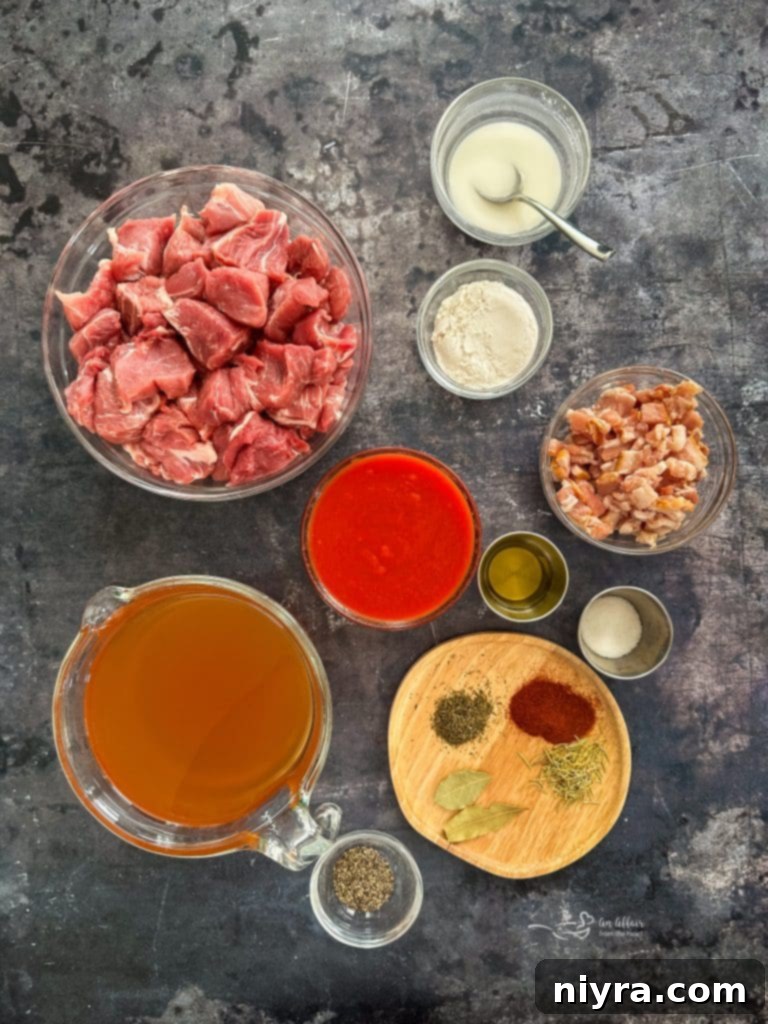
Essential Ingredients for a Flavorful Pork Stew
Crafting the perfect pork stew relies on a blend of classic ingredients that each play a vital role in building its signature deep and comforting flavors. Below you’ll find a comprehensive list of what you’ll need, along with helpful tips and potential substitutions. All precise measurements and detailed instructions are provided in the printable recipe card at the bottom of this post.
- Thick-cut bacon: More than just a garnish, bacon renders flavorful fat that creates a smoky, savory base layer for searing the pork and sautéing the aromatics. This initial step truly sets the stage for the stew’s rich profile.
- Pork shoulder roast (Boston Butt): This is the star of our stew for good reason. Its marbling and connective tissues are ideal for transforming into incredibly tender, juicy pork chunks after slow cooking. For alternative options, pork loin, pork tenderloin, or even pork chops can work as stew meat in a pinch, but be aware they are leaner and will yield a less rich and potentially drier result. The shoulder remains the top choice for its superior texture and flavor development.
- Salt and all-purpose flour: Dredging the cubed pork in this simple mixture serves a dual purpose. First, it helps the pieces of meat develop a beautiful, golden-brown crust when seared, locking in juices and adding texture. Second, the flour coating acts as a natural thickener for the stew, gradually enriching the broth as it simmers.
- Olive oil: Used in conjunction with the rendered bacon fat (or on its own if not using bacon) to sauté the vegetables and ensure everything cooks evenly, contributing to a cohesive flavor.
- Tomato sauce: A key ingredient that contributes acidity and umami, helping to build a rich, complex gravy with just the right amount of tang to balance the savory pork.
- Bay leaves, dried thyme, dried rosemary, and paprika: This quartet of classic stew seasonings forms the aromatic heart of the dish, infusing the broth with warmth and depth. For an extra layer of flavor, consider using smoked paprika, or add a teaspoon of red pepper flakes if you desire a little more heat and a subtle kick.
- Vegetable stock: Provides the foundational liquid for the stew, ensuring the flavors remain balanced and vibrant. Feel free to substitute with chicken broth, chicken stock, or beef broth if that’s what you have readily available; each will contribute its own unique undertones to the final dish.
- Cornstarch slurry: This simple mixture of cornstarch and water is whisked in at the end of the cooking process to thicken the stew into a luscious, rich gravy-like consistency. A small amount of all-purpose flour mixed with cold water can serve as an effective substitute if cornstarch is unavailable.
- Black pepper: Essential for adding a pleasant warmth and a touch of subtle spice, enhancing the overall savory profile of the stew.
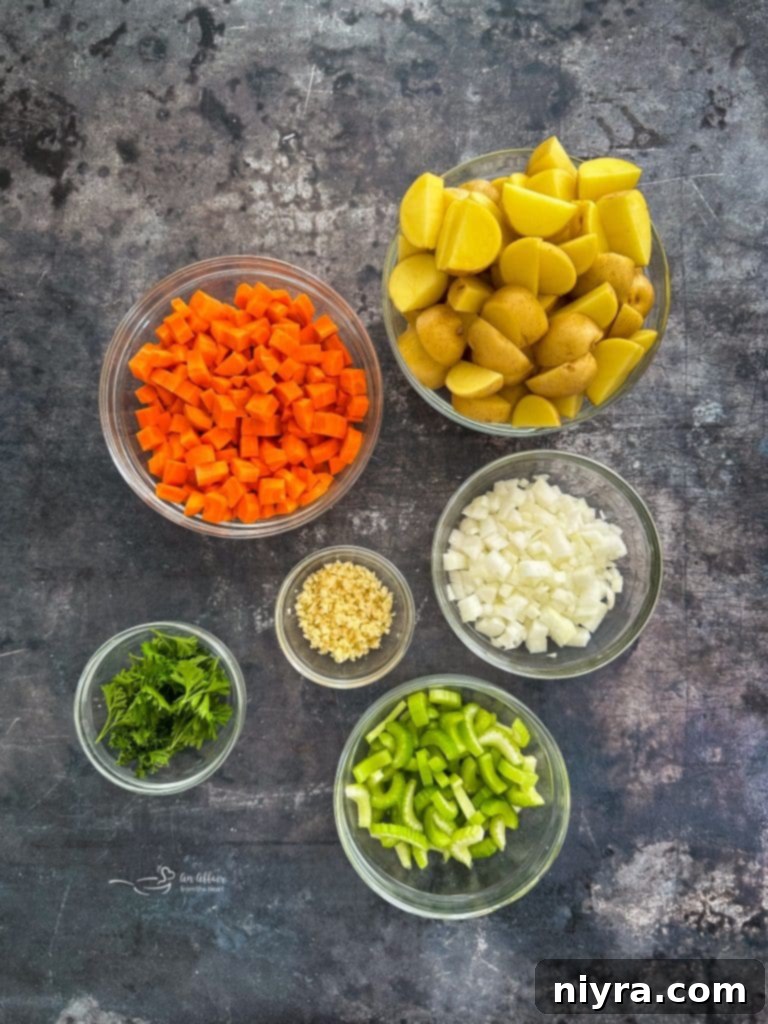
- Yukon gold potatoes: These potatoes are an excellent choice for stew because they hold their shape beautifully during extended cooking while developing a wonderfully buttery, soft texture. Russet potatoes can be used if you prefer a more starchy, falling-apart texture, or sweet potatoes for a touch of sweetness and vibrant color.
- Yellow onion and celery: These are the bedrock aromatics, forming the classic mirepoix base that provides a fundamental savory depth and mild sweetness to the stew. They are sautéed at the beginning to release their essential oils and flavors.
- Carrots: Adding both a touch of sweetness and vibrant color, carrots contribute a hearty element that beautifully balances the savory notes of the pork and broth. They soften wonderfully during the simmer, becoming tender and flavorful.
- Fresh garlic: A critical flavor enhancer, fresh minced garlic introduces a pungent, aromatic punch that brings out the depth of all the other ingredients in the broth, making the stew truly irresistible.
- Fresh parsley: Used as a finishing garnish, chopped fresh parsley adds a burst of bright, herbaceous freshness that cuts through the richness of the stew, providing a delightful contrast. Other fresh herbs like chives or extra thyme can also be sprinkled on just before serving for added aroma and visual appeal.
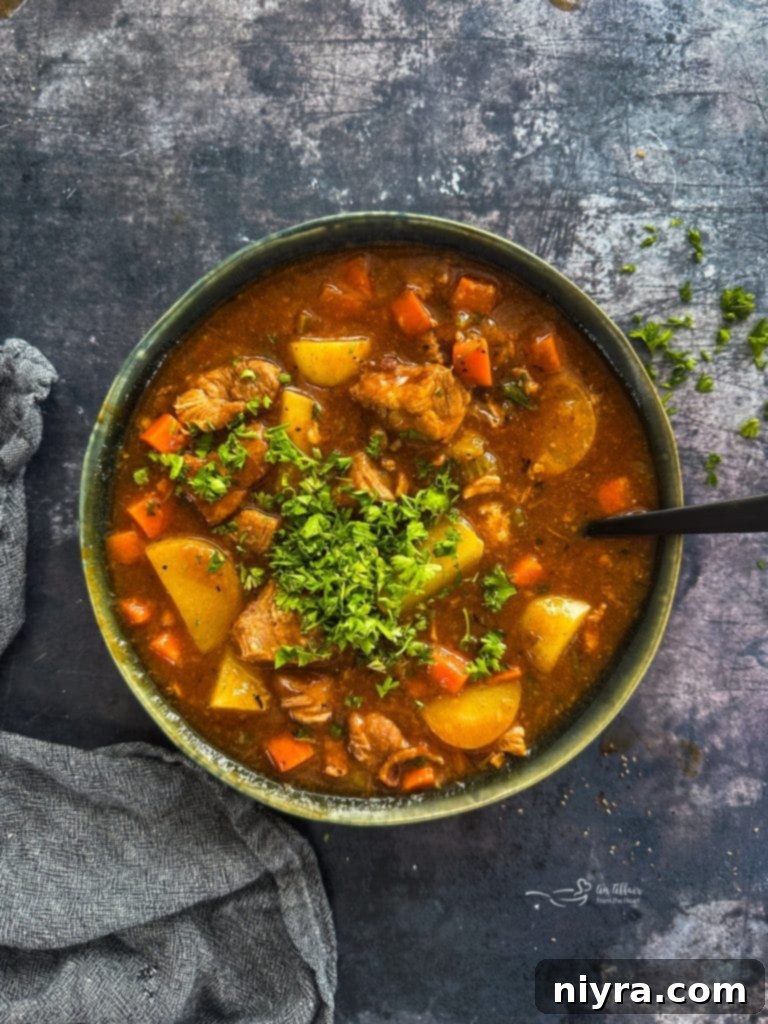
Step-by-Step Guide: How to Make This Irresistible Pork Stew
Once you’ve completed the initial preparation and chopping, this hearty pork stew comes together with surprising ease. The best part? Your kitchen will be filled with the most incredible, comforting aromas long before the first bite!
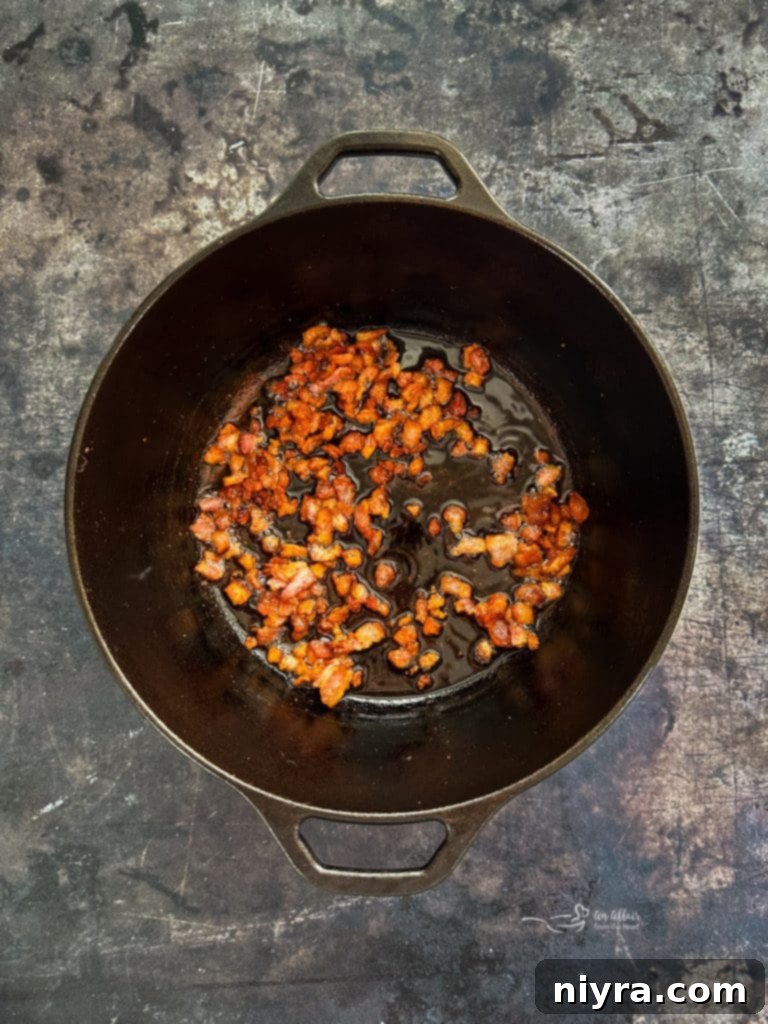
Begin by crisping the thick-cut bacon in a large, heavy-bottomed Dutch oven over medium-high heat. Cook until it’s beautifully golden and most of its fat has rendered out. Using a slotted spoon, transfer the crispy bacon pieces to a paper-towel-lined plate, ensuring you leave all those precious drippings in the pot. This bacon fat will be the foundation of our stew’s flavor.
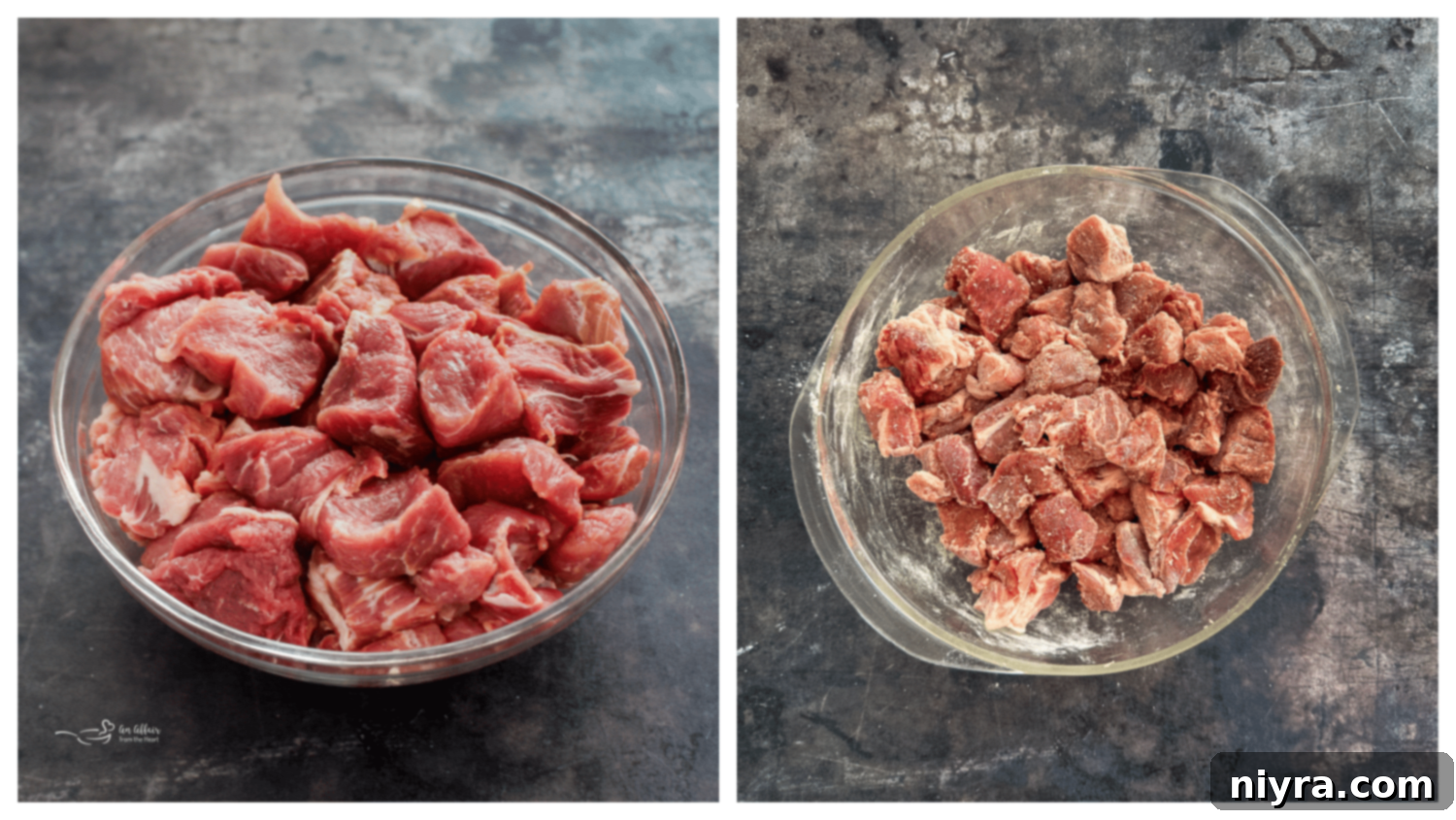
Next, dredge the cubed pork shoulder pieces in a mixture of all-purpose flour and salt. This coating will help create a beautiful crust and contribute to the stew’s thickness later. Ensure each piece is evenly coated.
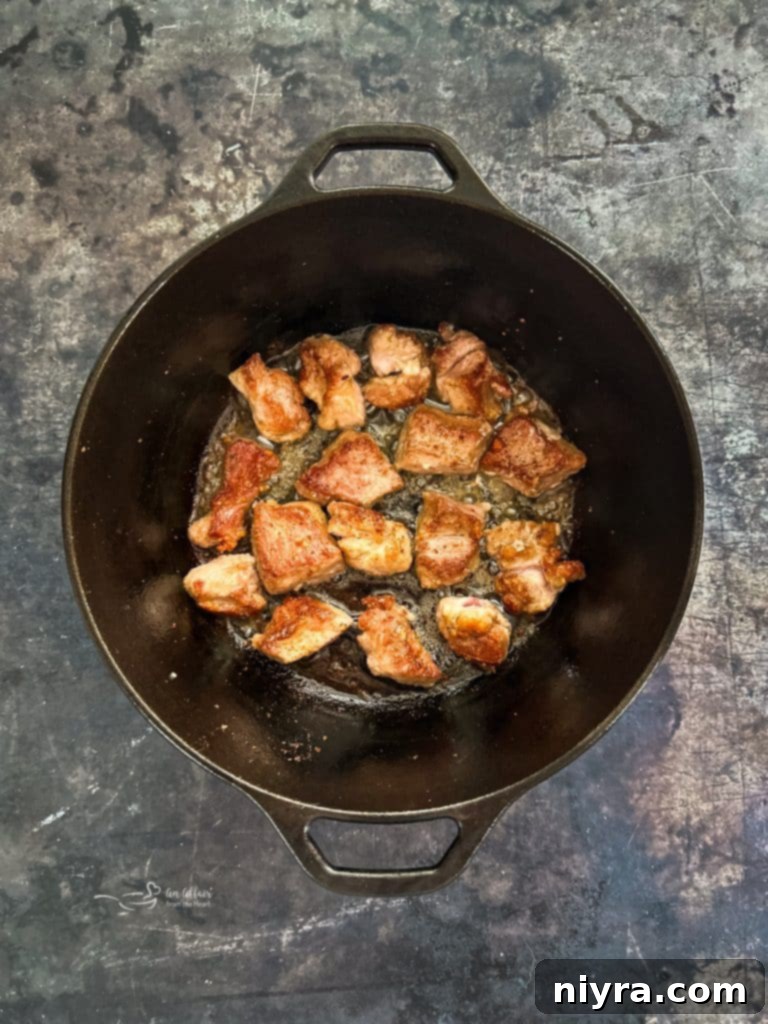
Sear the flour-coated pork pieces in batches in the same Dutch oven, using the reserved bacon drippings. Cook until each side is beautifully browned, developing a rich crust. It’s crucial not to overcrowd the pot, as this prevents proper browning and can lead to steaming instead of searing. Once browned, transfer the pork to the plate with the crispy bacon. Discard any excess fat from the pot and give it a quick wipe clean, leaving behind just the flavorful browned bits (fond) stuck to the bottom.

Add a tablespoon or two of olive oil to the pot, then sauté the diced yellow onion and celery over medium heat until they soften and become translucent, about 5-7 minutes. Stir in the minced fresh garlic and cook for just another minute until fragrant, being careful not to burn it. Next, add the tomato sauce, bay leaves, dried thyme, dried rosemary, and paprika. Crucially, as you stir, use a wooden spoon to scrape up all the browned bits (fond) from the bottom of the pot. These flavorful morsels are essential for building the stew’s deep, complex taste.
Return the seared pork and crispy bacon to the pot, then pour in the vegetable stock. Bring the mixture to a rolling boil over high heat, then immediately reduce the heat to low, ensuring it maintains a gentle simmer. Cover the Dutch oven and let the stew cook slowly for approximately 90 minutes. This extended simmering time allows the pork to become incredibly fork-tender, absorbing all the wonderful flavors of the broth.
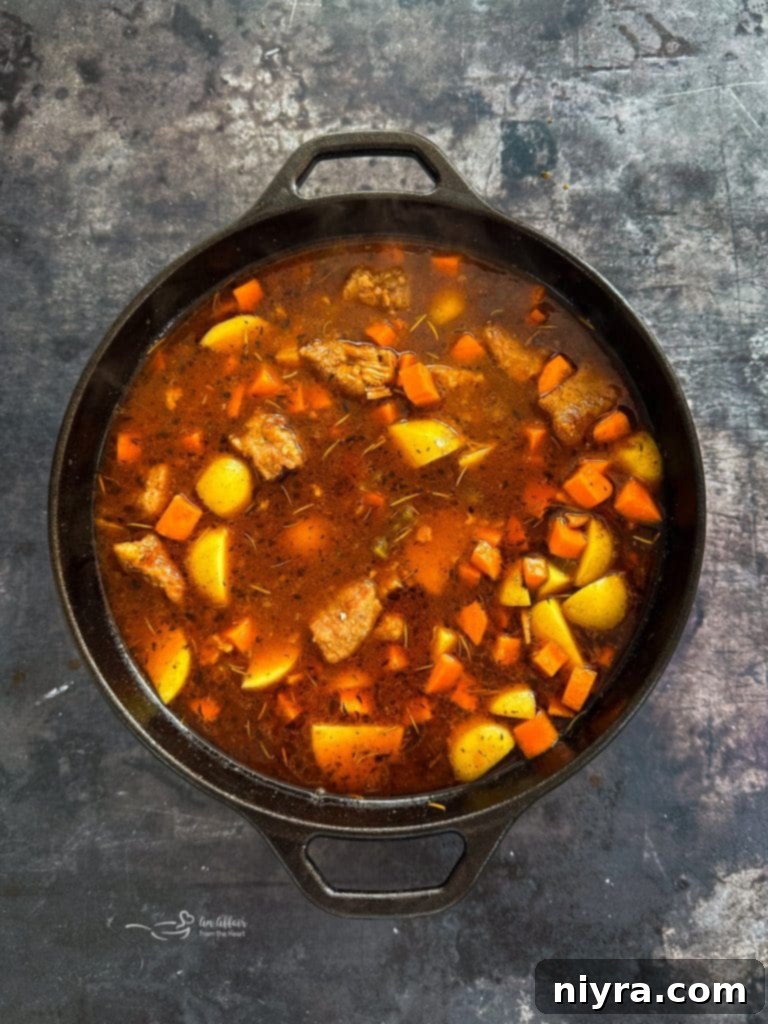
Uncover the pot and stir in the carrot and potato chunks. Cover again and continue simmering until these vegetables are tender, which usually takes about 30 minutes. Once the vegetables are cooked to your liking, remove and discard the bay leaves.
To achieve that perfect, rich stew consistency, stir in the cornstarch slurry (2 tablespoons cornstarch mixed with 2 tablespoons cold water) and continue to cook for about 5 more minutes, or until the broth has thickened to your desired level. Finally, taste the stew and adjust the seasoning with black pepper and more salt if needed. The flavors should be robust and well-balanced.
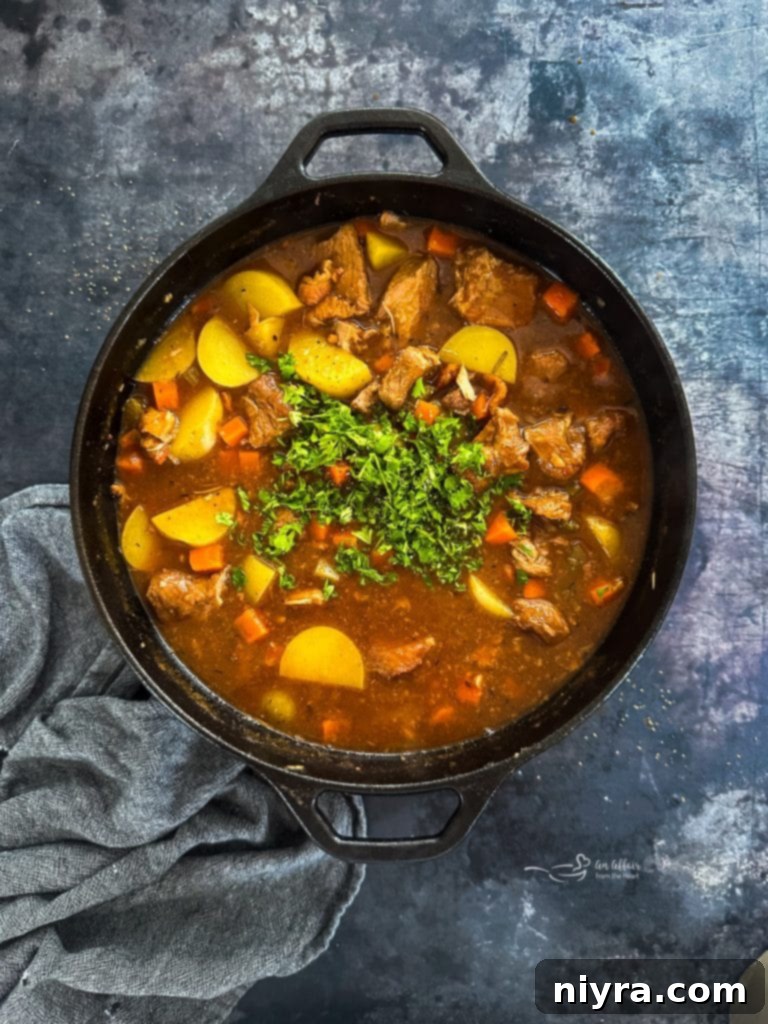
Ladle this magnificent pork stew into warm bowls. For a burst of freshness and color, sprinkle generously with chopped fresh parsley before serving. This hearty meal pairs wonderfully with a side of warm crusty Dutch oven bread, homemade buttermilk biscuits, fluffy mashed potatoes, or even a simple bed of white rice to soak up every last drop of that incredible gravy.
Slow Cooker Adaptation for Busy Days
For those days when you need a more hands-off approach, this pork stew recipe adapts beautifully to a slow cooker. You won’t sacrifice flavor, just some of the active cooking time:
- First, ensure you brown the pork shoulder and crisp the bacon using the stovetop method as outlined above. This crucial step develops deep flavors that are difficult to achieve solely in a slow cooker.
- Once browned, transfer the pork, bacon, and all remaining ingredients (except the fresh parsley) to your slow cooker pot.
- Cook on the LOW setting for 7–8 hours, or on HIGH for 3½–4 hours. The stew is ready when the pork is wonderfully fork-tender and the vegetables are thoroughly cooked.
- About 5-10 minutes before you plan to serve, stir in the cornstarch slurry (cornstarch mixed with water) to thicken the stew to your desired consistency. Taste and adjust the seasoning with salt and black pepper as needed. Garnish with fresh chopped parsley just before serving for a vibrant finish.
Storage and Reheating Tips for Delicious Leftovers
This hearty pork stew makes fantastic leftovers, often tasting even better the next day as the flavors have more time to meld. Here’s how to store and reheat it:
- Refrigerator: Allow the stew to cool completely to room temperature before transferring it to an airtight container. It will keep fresh in the refrigerator for up to 4 days.
- Freezer: For longer storage, portion the cooled stew into freezer-safe containers or heavy-duty freezer bags. Remember to leave a little headspace for expansion. It can be frozen for up to 3 months. When you’re ready to enjoy it, thaw the frozen stew overnight in the refrigerator before reheating.
- Reheating: Gently warm the stew on the stovetop over medium heat, stirring occasionally to ensure even heating. If the stew has thickened too much during storage, you can add a splash of vegetable stock, water, or even a touch of cream to achieve your desired consistency.
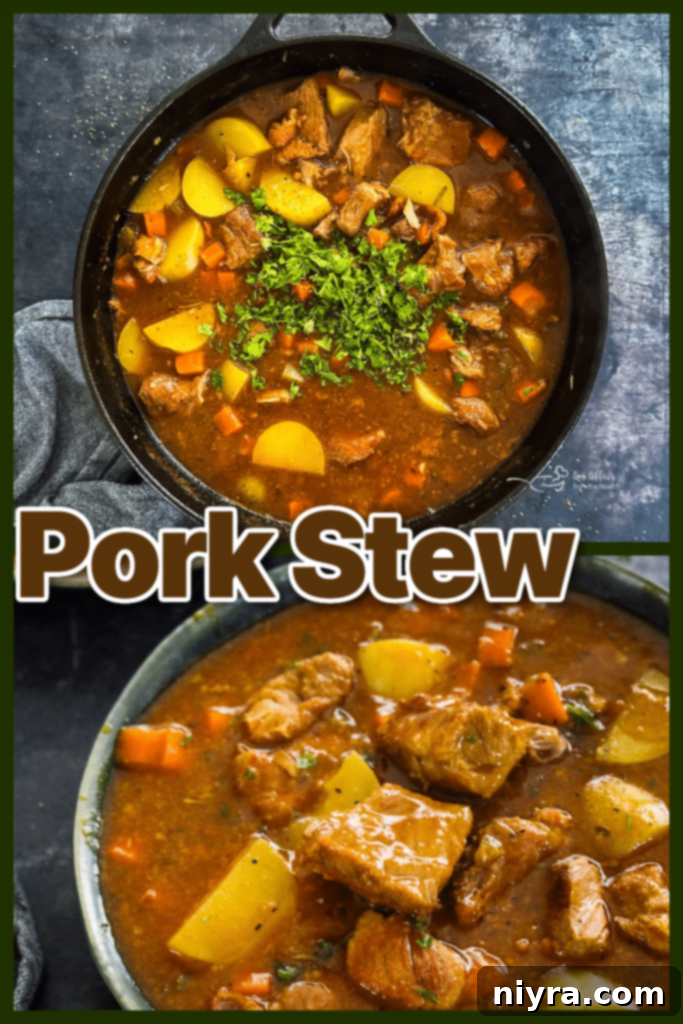
Love This Recipe? Pin It for Later!
If this comforting pork stew recipe has captured your imagination and you’re eager to try it, make sure you can easily find it when you’re ready to cook! Pin this recipe to your favorite Pinterest recipe board now, so it’s always just a click away.
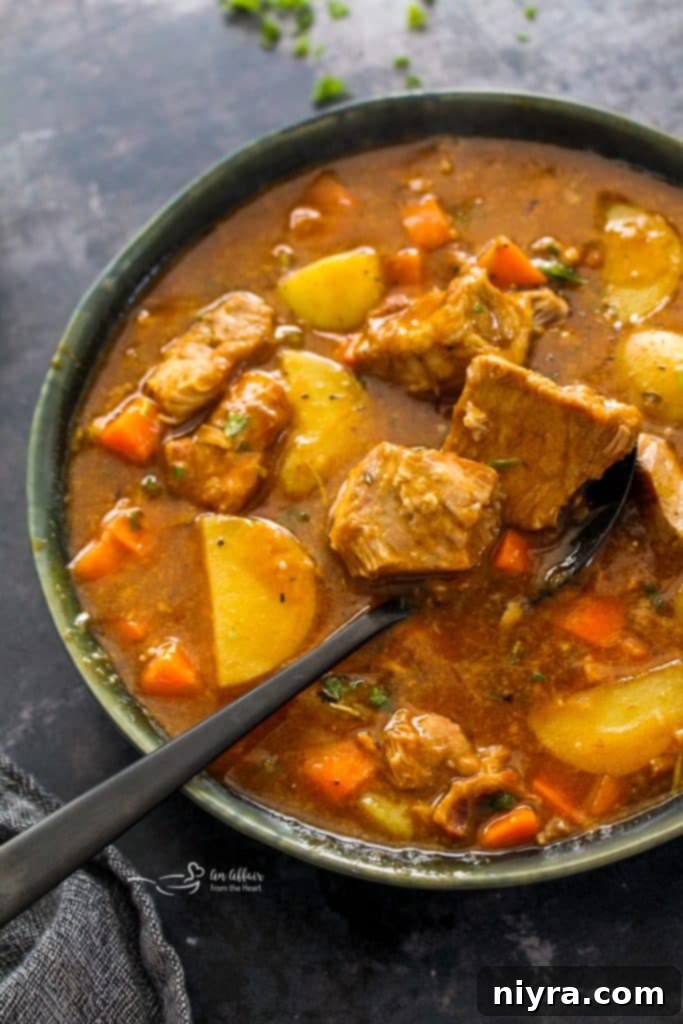
Achieving Perfection: The Importance of Internal Pork Temperature
Pork’s incredible versatility allows for a vast array of culinary preparations, each highlighting different cuts and cooking methods. On my site, you’ll discover a wealth of pork recipes that showcase this diversity. However, regardless of the cut or cooking style, understanding and monitoring the internal temperature of pork is paramount for both safety and optimal texture. Different cuts, from tenderloins to roasts, have specific ideal internal temperatures to ensure they are perfectly cooked without being dry or underdone. Thankfully, organizations like Iowa Pork provide invaluable resources, such as their comprehensive Pork Cooking Temperature Guide, which simplifies the process of knowing when your pork has reached its peak.
To accurately check for doneness, always use a reliable digital meat thermometer. Insert the thermometer into the thickest part of the pork cut, taking care to avoid touching any bone, which can give an inaccurate reading. Once the pork reaches the recommended internal temperature, remove it from the heat source and allow it to rest for at least three minutes before slicing or serving. This resting period is critical, as it allows the juices to redistribute throughout the meat, resulting in a more tender and flavorful final product. For stew meat, while fork-tenderness is key, a general internal temperature for safety is always good to keep in mind.

The Enduring Appeal and Benefits of Pork
While I may not have grown up on an Iowa farm, unlike my husband, pork has always held a special place at our family table. It was a cherished staple throughout my childhood, and one of my fondest memories is of my mom’s comforting Pork Chops with Mushroom Gravy – a recipe I now lovingly prepare for my own children. What they might not fully realize as they savor its delicious flavor, is the wealth of nutritional benefits that pork provides, making it a wholesome addition to any diet. Pork is an excellent source of protein, vitamins, and minerals, making it a powerhouse ingredient for growing families.
Iowa proudly stands as a leading producer of pork in the United States, with approximately one-third of the nation’s pork originating from its farms. Much of this high-quality pork is enjoyed right here at home, gracing dinner tables across the country. When you choose pork at your local grocery store, you’re doing more than just picking up ingredients for a meal; you are directly supporting the hardworking family farms in Iowa and countless other states across the United States. It’s a choice that connects you to a rich agricultural heritage and ensures that these producers can continue to provide quality ingredients for our favorite recipes.
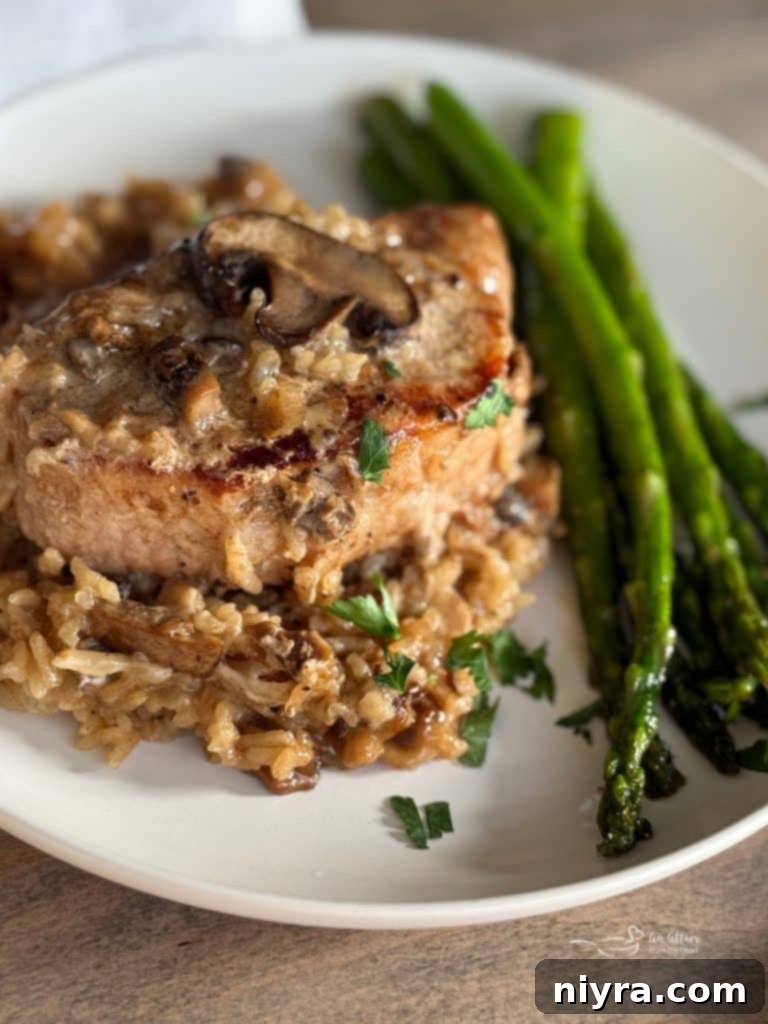
Explore More Irresistible Pork Recipes to Love
I’ve had the wonderful opportunity to collaborate with Iowa Pork for many years, and together we’ve created a treasure trove of delightful recipes. Among my absolute favorites are my grandma’s comforting Instant Pot Ham & Bean Soup, the indulgently savory Bacon Wrapped Pork Ribs, the famously easy Fuggedaboutit Pork Roast, a creamy and decadent Cream of Bacon Soup, and of course, those incredibly tender No Peek Pork Chops, beautifully pictured above. These recipes, and many more, celebrate the versatility and deliciousness of pork. You can discover my full collection of pork recipes right here on my website, perfect for any occasion or craving.

For continuous inspiration and a steady stream of delicious pork recipes throughout the year, be sure to follow along with Iowa Pork on their social media channels: Instagram, Facebook, Pinterest, and Twitter.
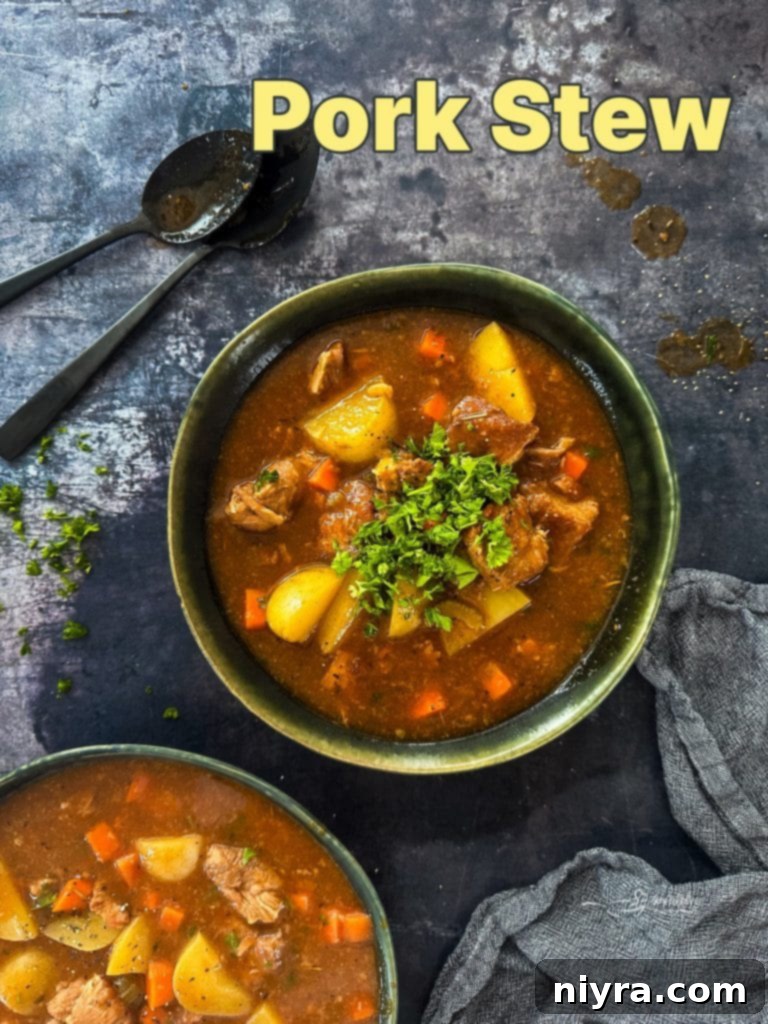
This hearty pork stew recipe truly is a culinary gem, perfect for cold winter nights, festive family gatherings, or simply when you crave a comforting meal. It masterfully combines wholesome ingredients with a rich, flavorful broth and succulent pork chunks that become exquisitely tender through slow cooking. Beyond its deliciousness, this recipe proudly showcases the exceptional quality of Iowa pork and celebrates the dedicated, hardworking farmers who raise it with such care. Their unwavering commitment to quality allows us to create heartwarming meals like this, fostering comfort, connection, and cherished memories around our tables.

LIKE THIS RECIPE?
Don’t forget to give it a ⭐️⭐️⭐️⭐️⭐️ star rating and
leave a comment below the recipe!

Print Recipe
Pork Stew
Equipment
- Lodge 6 Quart Enameled Cast Iron Dutch Oven. Classic Red Enamel Dutch Oven (Island Spice Red)
- AmazonBasics Enameled Cast Iron Covered Dutch Oven, 6-Quart, Blue
Ingredients
- 4 slices thick cut bacon chopped into small pieces
- 1 (3 pound) boneless pork shoulder roast or Boston Pork Butt Roast fat trimmed and cut into 1.5” chunks
- 1 ½ teaspoons salt
- ¼ cup all-purpose flour
- 2 Tablespoons olive oil
- 1 (medium-sized) yellow onion diced
- 2 ribs celery diced
- 4 (medium-sized) carrots cut into chunks
- 4 cloves garlic minced
- 1 (8 ounce can) tomato sauce
- 2 bay leaves
- ½ teaspoon dried thyme
- 1 teaspoon paprika
- ½ teaspoon dried rosemary
- 6 cups vegetable stock
- 4 Yukon gold potatoes about 2 pounds, cut into chunks
- 2 Tablespoons cornstarch + 2 Tablespoons water combined to make a slurry
- Salt and Pepper to taste
- Fresh parsley chopped, for serving
Instructions
- Add the bacon pieces to a large Dutch oven set over medium-high heat. Cook, stirring occasionally, until the bacon is crispy and the fat has rendered. Use a slotted spoon to transfer the bacon to a paper towel–lined plate, leaving the rendered fat in the pot.
- Combine the flour and salt in a shallow dish, then dredge the pork pieces in the mixture to coat. Working in batches, add the coated pork to the pot with the reserved bacon fat and cook until browned on all sides. Transfer the browned pork to the plate with the bacon. Discard any remaining fat in the pot. Wipe the pot clean.
- Pour the olive oil into the pot and set it over medium heat. When the oil is hot, add the onion and celery. Cook, stirring frequently, until the onion becomes translucent. Add the minced garlic and cook for about 1 minute, until fragrant. Stir in the tomato sauce, bay leaves, thyme, rosemary, and paprika.
- Return the bacon and pork to the pot and pour in the stock. Bring the mixture to a boil over high heat, then reduce the heat to maintain a gentle simmer. Cover and cook, stirring occasionally, until the meat is very tender, about 1½ hours.
- Uncover the pot and stir in the carrot and potato chunks. Cover again and continue cooking, stirring occasionally, until the vegetables are fork-tender, about 30 minutes. Remove and discard the bay leaves.
- Stir the cornstarch slurry into the pot and cook for about 5 more minutes, until the stew has thickened.
- Taste and adjust the seasoning with salt and pepper as needed.
- Ladle into bowls and garnish with chopped parsley before serving.
Notes
Slow Cooker Instructions
- Brown the pork shoulder and bacon as you do with the stovetop method before adding to the slow cooker.
- Add the browned pork, bacon, and the rest of the ingredients, with the exception of the parsley, to the slow cooker.
- Cook on LOW for 7–8 hours or HIGH for 3½–4 hours, until the pork is fork-tender and the vegetables are cooked through.
- About 5 minutes before serving, stir in the cornstarch slurry to thicken the stew. Taste and season with salt and black pepper. Garnish with fresh parsley when serving.
Storage Tips for Leftovers
- Refrigerator: Let the stew cool, then store in an airtight container for up to 4 days.
- Freezer: Portion cooled stew into freezer-safe containers or bags, leaving room for expansion. Freeze for up to 3 months. Thaw overnight in the refrigerator before reheating.
- Reheating: Warm gently on the stove over medium heat, stirring occasionally. Add a little stock or water if the stew has thickened too much.
